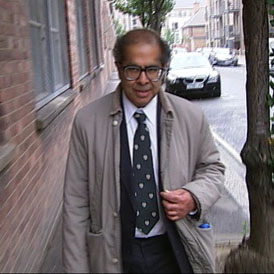G20 Tomlinson pathologist accused of misconduct
The pathologist who ruled Ian Tomlinson died of a heart attack at the G20 protests is accused of misconduct in four other post mortems. Simon Israel was at the General Medical Council hearing.

Dr Freddy Patel appeared before the General Medical Council on Monday accused of misconduct over his failings in a total of four autopsies performed between September 2002 and August 2004.
He is accused of giving “questionable” verdicts on the causes of deaths, several of which later turned out to be suspicious.
Dr Patel had carried out the post mortem on Ian Tomlinson, the man who died during the G20 protests, concluding his death was due to heart attack. A second post mortem examination, carried out after amateur video footage revealed Mr Tomlinson had been struck and pushed by a Metropolitan Police officer, found the death was caused by an abdominal haemorrhage.
However, none of the allegations heard today relate to Mr Tomlinson’s death.
Patel had previously been reprimanded by the GMC, after he released medical details about 30 year old Roger Sylvester, who died controversially in police custody.
Patel quit academic and NHS posts in 1998 to become a private pathologist on the Home Office register, however he has been suspended from the register since last June and barred from undertaking post mortems in suspicious deaths.
Patient A
In one of the cases, the doctor was called out by Metropolitan Police to view a body found in bushes in west London. Patient A, 21 year old Maja Trajkovic, was found lying on her back, partially clothed and police were treating the death as suspicious.
The GMC claims Dr Patel failed to take a sample to help identify the time of death. During the post mortem the woman was found to have been taking heroin, but Dr Patel failed to take a hair sample to establish long term use of drugs.
In recording the cause of death as opiate poisoning, the GMC was told Dr Patel “failed to have regard for all the available or obtainable evidence and that he reached a conclusion as to the cause of death which was not supported by the evidence.”
A second post mortem was carried out in which the pathologist said the cause of death was ‘unascertainable’, but gave asphyxia as a possible cause. Patel later changed his report to include a reference to asphyxia.
Simon Jackson QC told the hearing Dr Patel did not leave the issue open to allow for further investigation by police, stating; “The reality is that once a consultant forensic pathologist has identified a cause of death which appears to exclude criminal activities, the impetus for criminal investigation is or may be lost.”
Patient B
Dr Patel also faces allegations in the case of Patient B, known to be five year old Annastacia Williams, who died after sustaining severe head injuries at her home in north London in 2002.
Annastacia’s step mother was later convicted of cruelty in relation to the child’s death and her father also jailed for turning a blind eye to the abuse. It is alleged that Patel failed to spot signs of possible abuse on her body.
Mr Jackson told the hearing Dr Patel “should have made enquiries with the hospital before his post mortem which may have raised concerns as to whether this child has sustained non-accidental injuries.”
In the event she was buried and later exhumed for a second examination.
Patients C and D
Patient C was a four week old baby girl. Dr Patel is alleged to have failed to obtain full skeletal x-rays or samples for histological examinations and is alleged to have carried out an examination that was “not of the standard expected of a competent Home Office registered forensic pathologist.”
And in the case of Patient D, Dr Patel recorded a cause of death as coronary artery disease when it was later proved to be intracerebral haemorrhage. During this case he is alleged to have failed to examine the height and weight of the deceased, open the skull, examine the central nervous system or take samples for toxicological examination.
A fifth case
During the hearing an attempt to add a new set of charges in relation to a fifth case was thrown out with the GMC ruling it would be unfair for Patel to face charges over his post mortem.
The fifth charge detailed the 2002 case of 38 year old Sally White. Her death was being treated as suspicious until Dr Patel detailed she died of a natural causes resulting from heart disease.
White’s body was found locked in a bedroom in the Camden flat of Anthony Hardy, a 52-year-old psychiatrically-disturbed alcoholic. Anthony Hardy went on to kill two more women, Elizabeth Valad and Brigette MacClennan, dumping their body parts in bin bags. He later admitted killing Sally White.
Dr Patel has been under investigation by the GMC since 2005.
He faces 26 charges and, if found guilty, could be struck off.